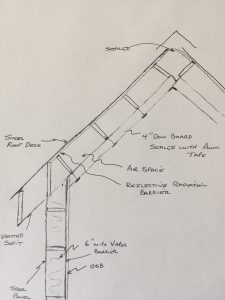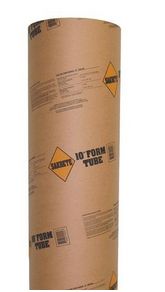This week the Pole Barn Guru answers questions about uplift concerns, retro-fitting insulation, and setting posts in high water tables.
DEAR POLE BARN GURU: I am adding an open overhang to the gable end of my 40×80 pole barn. I bought 36’ trusses and will lower them to fit under the existing gable going out 16’. Since the underside is unfinished should I worry about wind uplift? SCOTT in SHERIDAN
 DEAR SCOTT: Regardless of whether your addition will be open, enclosed, or somewhere in between uplift should always be a consideration. Ideally the original EOR (Engineer of Record) who designed your 40′ x 80′ building would be consulted, not only because of a potential uplift issue, but also due to what affect open carport will have upon existing building. You may be placing wind shear issues upon endwall closest to addition and these will need to be addressed, as well as if endwall column footings will be adequate to support added weight (not just dead load, but also potential weight of a snowfall). An issue of drifting needs to be reviewed also, as snow could build up upon carport roof against existing endwall.
DEAR SCOTT: Regardless of whether your addition will be open, enclosed, or somewhere in between uplift should always be a consideration. Ideally the original EOR (Engineer of Record) who designed your 40′ x 80′ building would be consulted, not only because of a potential uplift issue, but also due to what affect open carport will have upon existing building. You may be placing wind shear issues upon endwall closest to addition and these will need to be addressed, as well as if endwall column footings will be adequate to support added weight (not just dead load, but also potential weight of a snowfall). An issue of drifting needs to be reviewed also, as snow could build up upon carport roof against existing endwall.
If original EOR proves unavailable (or nonexistent), you should enlist services of a competent RDP (Registered Engineer or Architect) qualified to review your existing building, as well as your intended work.
DEAR POLE BARN GURU: Need your suggestions on any improvements I can make. Below is a sketch of my current building roof insulation. Basically I tried to seal off the cathedral ceiling using the bottom of the purlins to hang 4” Dow board sealed with aluminum tape. I did purchase the radiant reflective barrier that was installed per instructions between the roof purlins and the steel roof panels. I live in Michigan.
 I love my two pole buildings I purchased from you guys. Just need some help on insulating the roof on my last building. Nothing is wrong. Just concerned about the un-vented dead air space. JOHN in SAGINAW
I love my two pole buildings I purchased from you guys. Just need some help on insulating the roof on my last building. Nothing is wrong. Just concerned about the un-vented dead air space. JOHN in SAGINAW
DEAR JOHN: Always glad to hear back from happy building owners! As long as the cavity was dry when it was sealed up, and the Dow board is sufficiently well sealed there is a chance you will not have problems. The only guaranteed solutions involve having to take down the insulation board and make provision for airflow from eave intake to ridge exhaust by drilling holes through all of the purlins.
DEAR POLE BARN GURU: Mike can you please tell me what is the proper way to set posts in holes that have water. High water table. Thanks much I enjoy your blog. PATRICK
 DEAR PATRICK: Back when I was a contractor we would run into this situation occasionally. Our solution then was to stand columns in holes, brace them and then backfill with pre-mix concrete with very little water in it. Concrete weight would displace water in hole. It did take a significant amount of concrete, however it was only about $30 a yard then.
DEAR PATRICK: Back when I was a contractor we would run into this situation occasionally. Our solution then was to stand columns in holes, brace them and then backfill with pre-mix concrete with very little water in it. Concrete weight would displace water in hole. It did take a significant amount of concrete, however it was only about $30 a yard then.
How I would do it now – I would use sonotubes equal to or larger in diameter than what was specified by engineer. Cut tubes to depth of hole length, then cover one end of tube with six ml black visqueen (read about visqueen history here: https://www.hansenpolebuildings.com/2013/07/moisture-barrier/ ) sealed tightly around sides of tube. Place tube in hole with covered end down (this will take some work, as tube will want to float like a boat). Once sonotube has been placed, backfill around outside with compactable material – compacting no more than every six inches. Then stand column in tube, brace it and backfill with pre-mix concrete as engineer specified.






